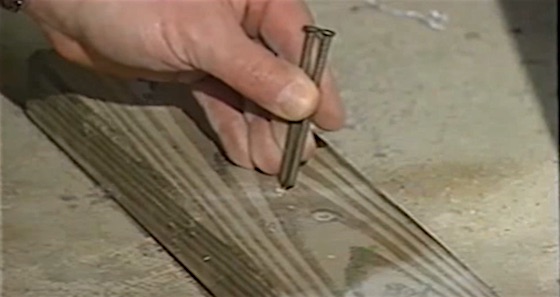How to Use Common Nails to Attach Wood to Concrete

Concrete nails can be just regular 16d sinker nails. Two side-by-side will fit tight in a 1/4-inch-diameter hole in the concrete. Copyright 2018 Tim Carter
Attach Wood to Concrete - Easy With Sinker Nails
"Take two of the 16d coated sinker nails and hold them together so the heads of the nails are even. Tap both nail heads at the same time lightly until they..."
Related Links
Deck Screws vs Nails - Which is Better?
Nail Guns - Drive Many Nails Fast
Free & Fast Bids
Concrete Nails Can Be Regular 16d Sinker Nails
IMPORTANT NOTE: What you see in the video using regular nails should only be done when you know the wood will NEVER GET WET. If you use this method outdoors with treated lumber, then you MUST USE stainless-steel nails or double-dipped hot galvanized nails. You'll have to upsize the drilled hole to 5/16ths or 3/8th inches. Experiment until you have moderate resistance hammering in the nails.
You can use regular 16d sinker nails as concrete nails in an upcoming project where you need to attach a piece of treated lumber to a poured concrete slab or a wall. The wood could be a 2 x 4 bottom plate for a wall or a simple 2 x 2 cleat for some utility shelving in your basement or garage.
I remember my dad drilling a large hole into dense concrete to install lead anchors to achieve this goal. It took hours and hours. Fortunately, I discovered my own way using regular 16 penny coated sinker nails and a hammer drill to permanently attach wood to concrete faster than you can say Jiminy Cricket. I can drill ten holes and install the nails in less than 15 minutes!
Degree of Difficulty: 
What Tools and Nails Do You Need?
You’ll just need a one-pound box of 16d coated sinker nails, a 20-ounce hammer, and a roto-hammer drill equipped with a 1/4-inch carbide-tipped bit that can drill a hole 6 inches deep.
Should the Wood Be Treated Using Concrete Nails?
Be sure the wood you’re using is treated lumber. It’s always a good idea to use treated lumber for any wood in contact with poured concrete.
Concrete can become damp from contact with soil causing regular lumber to rot. Wood-destroying insects like carpenter ants and termites are often found near poured concrete that’s touching wet or damp soil. These insects do not like to eat treated lumber.
Where Should I Position the Wood?
Position the wood exactly where you want it to be when contacting the poured concrete. If it’s a bottom plate for a wall, gravity will hold it in place for you. If it’s a cleat for wall shelving, you may want to enlist a helper to hold the wood tight against the wall as you operate the drill.
Should the Drill Be in Hammer Mode?
Turn on the drill making sure it’s in the hammer mode. Hammer drills are amazing tools that use a rapid back and forth hammer motions while the drill is also rotating. The hammer blasts pulverized poured concrete and drilling is very easy.
Will the Hammer Drill Penetrate the Wood Plate?
The hammer drill will easily penetrate the wood. You don’t need to pre-drill a hole in the wood with a wood bit before using the carbide masonry bit. Just drill into the wood with the carbide bit.
Should the Drill Be Pulled From the Hole While Drilling?
Once the bit starts to bite into the poured concrete creating dust, extract the bit from the concrete and wood about every five seconds as you drill. This helps pull up to the surface much of the concrete dust and particles creating less friction on the sides of the drill bit. Apply even pressure on the drill as you drill down.
How Deep Should I Drill Into the Concrete?
Continue drilling until the hole in the poured concrete is at least two and one-half inches deep. If you’re drilling through 2x material this means four inches of the six-inch-long drill bit must be buried in the wood and concrete. (1.5 + 2.5 = 4 inches)
How Many 16d Sinker Nails Should I Use?
Take two of the 16d coated sinker nails and hold them together so the heads of the nails are even. Tap both nail heads at the same time lightly until they come in contact with the poured concrete.
Continue striking the nails with the hammer with heavier blows making sure the hammerhead strikes the nails squarely in the center of the hammerhead. Short strong hammer strokes are better than wild large strokes that can bend the nails.
How Well Do the Two Nails Hold in the Concrete?
The combined diameter of the two 16d sinker nails is perfect to produce a very strong bite into the concrete. If you do this right and the concrete is strong, you often need a crowbar to extract the nails at a later date.
Column HT021

